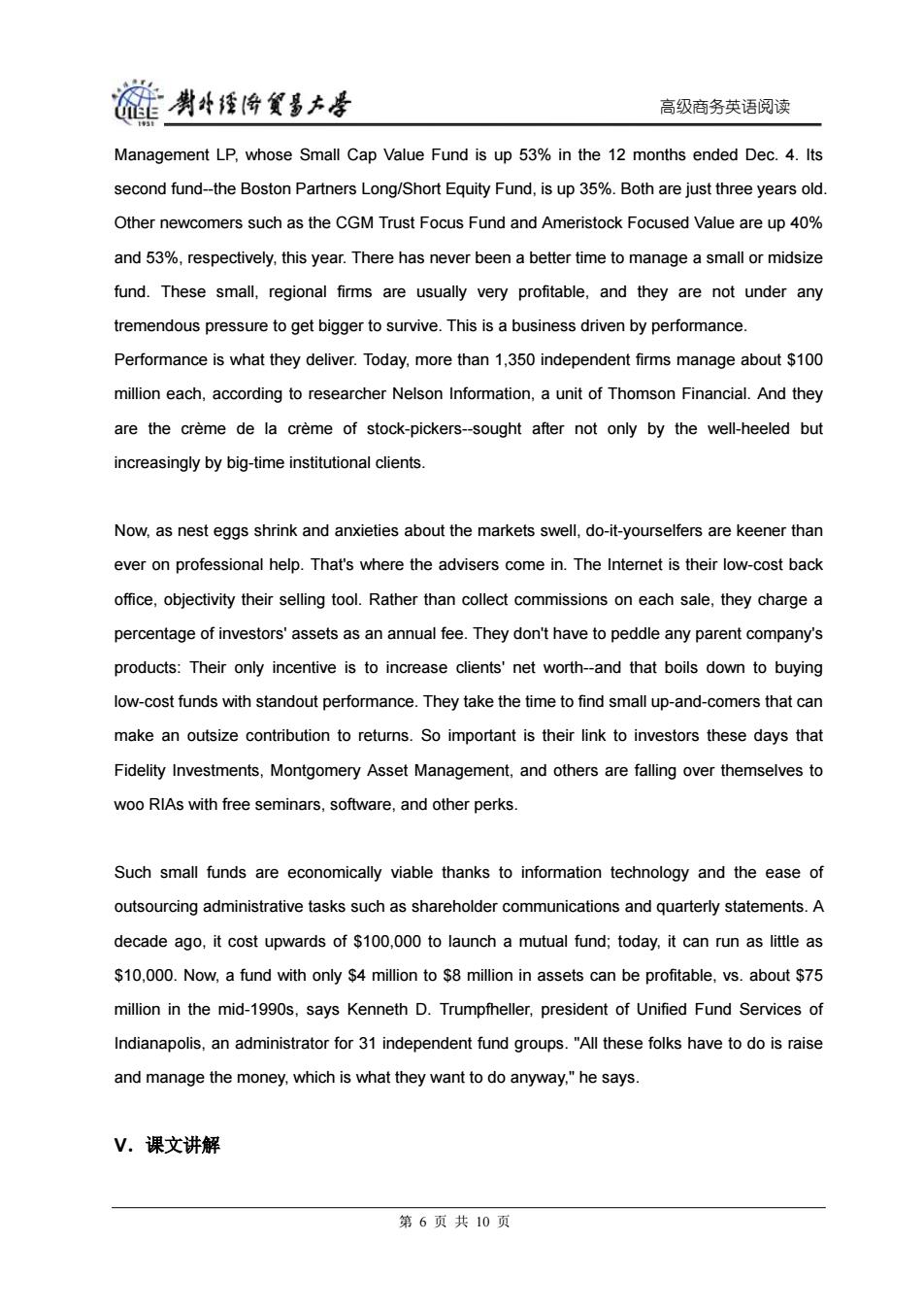正在加载图片...

旋类科桂将贸多大 高级商务英语阅读 Management LP,whose Small Cap Value Fund is up 53%in the 12 months ended Dec.4.Its second fund--the Boston Partners Long/Short Equity Fund,is up 35%.Both are just three years old. Other newcomers such as the CGM Trust Focus Fund and Ameristock Focused Value are up 40% and 53%,respectively,this year.There has never been a better time to manage a small or midsize fund.These small,regional firms are usually very profitable,and they are not under any tremendous pressure to get bigger to survive.This is a business driven by performance. Performance is what they deliver.Today,more than 1,350 independent firms manage about $100 million each,according to researcher Nelson Information,a unit of Thomson Financial.And they are the creme de la creme of stock-pickers--sought after not only by the well-heeled but increasingly by big-time institutional clients. Now,as nest eggs shrink and anxieties about the markets swell,do-it-yourselfers are keener than ever on professional help.That's where the advisers come in.The Internet is their low-cost back office,objectivity their selling tool.Rather than collect commissions on each sale,they charge a percentage of investors'assets as an annual fee.They don't have to peddle any parent company's products:Their only incentive is to increase clients'net worth--and that boils down to buying low-cost funds with standout performance.They take the time to find small up-and-comers that can make an outsize contribution to returns.So important is their link to investors these days that Fidelity Investments,Montgomery Asset Management,and others are falling over themselves to woo RIAs with free seminars,software,and other perks. Such small funds are economically viable thanks to information technology and the ease of outsourcing administrative tasks such as shareholder communications and quarterly statements.A decade ago,it cost upwards of $100,000 to launch a mutual fund;today,it can run as little as $10,000.Now,a fund with only $4 million to $8 million in assets can be profitable,vs.about $75 million in the mid-1990s,says Kenneth D.Trumpfheller,president of Unified Fund Services of Indianapolis,an administrator for 31 independent fund groups."All these folks have to do is raise and manage the money,which is what they want to do anyway,"he says. V.课文讲解 第6页共10页高级商务英语阅读 Management LP, whose Small Cap Value Fund is up 53% in the 12 months ended Dec. 4. Its second fund--the Boston Partners Long/Short Equity Fund, is up 35%. Both are just three years old. Other newcomers such as the CGM Trust Focus Fund and Ameristock Focused Value are up 40% and 53%, respectively, this year. There has never been a better time to manage a small or midsize fund. These small, regional firms are usually very profitable, and they are not under any tremendous pressure to get bigger to survive. This is a business driven by performance. Performance is what they deliver. Today, more than 1,350 independent firms manage about $100 million each, according to researcher Nelson Information, a unit of Thomson Financial. And they are the crème de la crème of stock-pickers--sought after not only by the well-heeled but increasingly by big-time institutional clients. Now, as nest eggs shrink and anxieties about the markets swell, do-it-yourselfers are keener than ever on professional help. That's where the advisers come in. The Internet is their low-cost back office, objectivity their selling tool. Rather than collect commissions on each sale, they charge a percentage of investors' assets as an annual fee. They don't have to peddle any parent company's products: Their only incentive is to increase clients' net worth--and that boils down to buying low-cost funds with standout performance. They take the time to find small up-and-comers that can make an outsize contribution to returns. So important is their link to investors these days that Fidelity Investments, Montgomery Asset Management, and others are falling over themselves to woo RIAs with free seminars, software, and other perks. Such small funds are economically viable thanks to information technology and the ease of outsourcing administrative tasks such as shareholder communications and quarterly statements. A decade ago, it cost upwards of $100,000 to launch a mutual fund; today, it can run as little as $10,000. Now, a fund with only $4 million to $8 million in assets can be profitable, vs. about $75 million in the mid-1990s, says Kenneth D. Trumpfheller, president of Unified Fund Services of Indianapolis, an administrator for 31 independent fund groups. "All these folks have to do is raise and manage the money, which is what they want to do anyway," he says. V.课文讲解 第 6 页 共 10 页